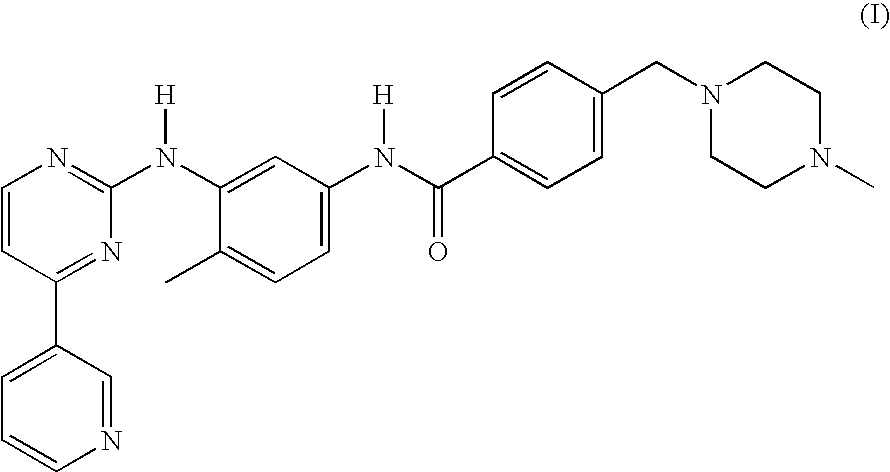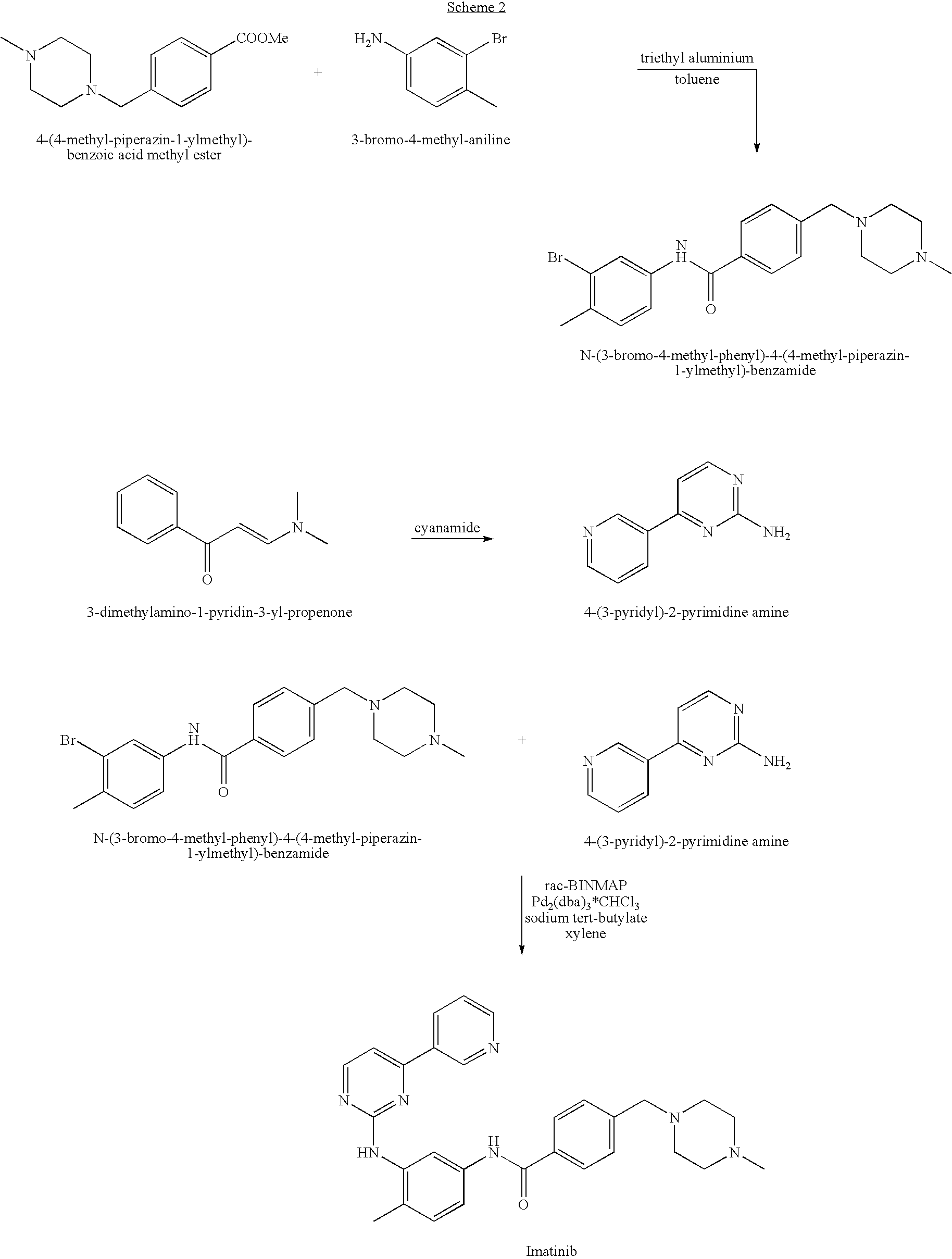Imatinib production process
a technology of imatinib and production process, which is applied in the field of imatinib production process, can solve the problems of not being suitable for commercial production, not being particularly suitable for industrial purposes, and being expensive in catalysts
- Summary
- Abstract
- Description
- Claims
- Application Information
AI Technical Summary
Problems solved by technology
Method used
Image
Examples
example 1
[0074]This example describes the preparation of imatinib base.
[0075]A reaction vessel was charged with 11 g (0.04 mol) of N-(5-amino-2-methylphenyl)-4-(3-pyridyl)-2-pyrimidine-amine and 13.4 g (0.044 mol) of 4-(4-methyl-piperazinomethyl)-benzoic acid at ambient temperature and 44 ml of THF and 66 ml of water were added. The mixture was stirred for about 20 minutes to obtain a solution and cooled back to ambient temperature. 9.24 g of EDC HCl was added in several portion during a period of 10 minutes and stirred for one hour.
[0076]114 ml of dichloromethane and 29 ml of ethanol were then added and the pH was adjusted to a value that ranges between 8-9 with 17.6 ml of 20% NaOH. The phases were separated and the aqueous solution was extracted with 22 ml of a 4 / 1 (v / v) mixture of dichloromethane and ethanol. The organic phases were combined and concentrated to about 90 ml under vacuum and 90 ml of ethanol was added followed by concentrating the volume to 80 ml. The mixture was cooled to ...
example 2
[0077]This example describes the crystallization of crude imatinib base. A reaction vessel was charged with 15.5 g of the crude imatinib base of example 1, and 121 ml of about 4 / 1 mixture (v / v) of dichloromethane / ethanol was added at ambient temperature. The insoluble matter was filtered off and the remaining solution was concentrated under vacuum. 130 ml of ethanol was added to the concentrate and the mixture was concentrated to a volume of about 130 ml. The mixture was cooled to a temperature of 0-5° C. and mixing was maintained for an hour. The mixture was filtered and the thus formed precipitate was collected by filtration and washed with 3×20 ml of ethanol and dried to afford 14.2 grams of imatinib base in 72% yield, having 99.8% purity, and containing 0.01% of the starting material N-(5-amino-2-methylphenyl)-4-(3-pyridyl)-2-pyrimidine-amine (according to HPLC).
example 3
[0078]This example describes the preparation of crystalline imatinib mesylate from imatinib base.
[0079]A three-necked reaction vessel equipped with a thermometer, a reflux condenser and a mixer was charged with 1.004 gram of imatinib base (2.04 mmoles) under nitrogen atmosphere and mixed with 30 ml of 4-methylcyclohexalnone. The mixture was heated to 65° C. and 375 μL of methanesulfonic acid were mixed with 30 ml of 4-methylcyclohexanone to form a solution, and 11 ml (2.04 mmoles) of the thus formed methanesulfonic acid solution was slowly added to the solution of imatinib base. At the end of the addition the obtained suspension was cooled to room temperature and the resulting wet crystals of imatinib mesylate were filtered and dried. The purity by HPLC was 99.6%.
PUM
| Property | Measurement | Unit |
|---|---|---|
| volume | aaaaa | aaaaa |
| volume | aaaaa | aaaaa |
| volume | aaaaa | aaaaa |
Abstract
Description
Claims
Application Information
 Login to View More
Login to View More - R&D
- Intellectual Property
- Life Sciences
- Materials
- Tech Scout
- Unparalleled Data Quality
- Higher Quality Content
- 60% Fewer Hallucinations
Browse by: Latest US Patents, China's latest patents, Technical Efficacy Thesaurus, Application Domain, Technology Topic, Popular Technical Reports.
© 2025 PatSnap. All rights reserved.Legal|Privacy policy|Modern Slavery Act Transparency Statement|Sitemap|About US| Contact US: help@patsnap.com



